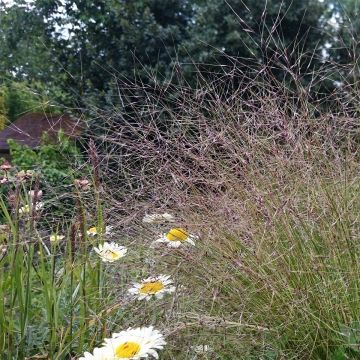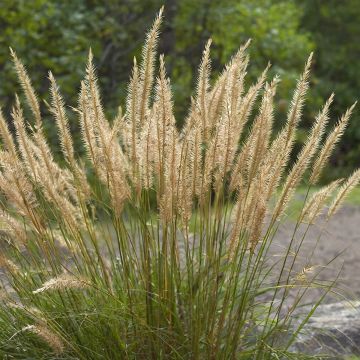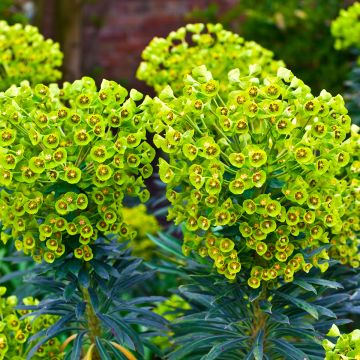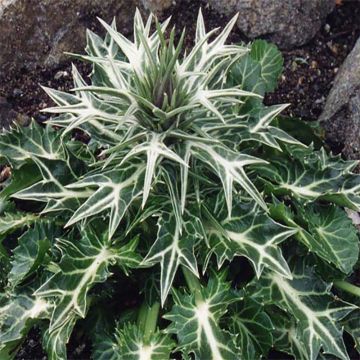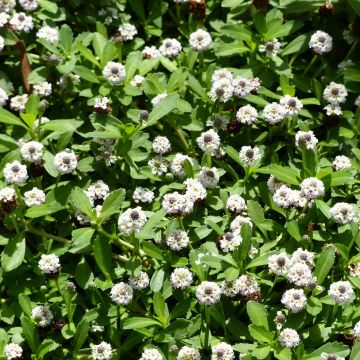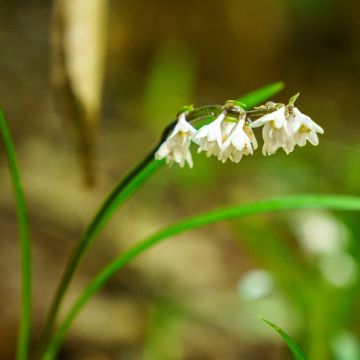

Stipa arundinacea Sirocco


Stipa arundinacea Sirocco


Stipa arundinacea Sirocco
Stipa arundinacea Sirocco
Stipa arundinacea 'Sirocco'
Pheasant's Tail Grass, New Zealand Wind Grass
This plant carries a 12 months recovery warranty
More information
We guarantee the quality of our plants for a full growing cycle, and will replace at our expense any plant that fails to recover under normal climatic and planting conditions.
From €5.90 for pickup delivery and €6.90 for home delivery
Express home delivery from €8.90.
From €5.90 for pickup delivery and €6.90 for home delivery
Express home delivery from €8.90.

Does this plant fit my garden?
Set up your Plantfit profile →
Description
Stipa arundinacea 'Sirocco', also known as Anemanthele lessoniana 'Sirocco', is a magnificent ornamental grass, forming a colourful fountain all year round! Its evergreen foliage is variegated with green and burnt orange in summer, while its tall plume-like inflorescences appear in purple-brown spikes. Winter and cold weather turn it rusty brown, extending the spectacle of an endless autumn. It is a very robust plant for mild climates. While it thrives in dry, chalky, and poor soil, it dislikes humidity and winter cold.
Stip arundinacea 'Sirocco' is a rhizomatous perennial grass native to New Zealand belonging to the Poaceae family, which is rare in the wild. The graceful, flexible plant forms a clump of tapering leaves 80 cm (32in) to 1.20 m (4ft) high, with a diameter of about 40 cm (16in) at the base. The young spring leaves are medium green, turning a dark green shade variegated with burnt orange in summer, and then becoming rusty in winter. The foliage is evergreen if the winter is mild, but it disappears in severe frost. Flowering occurs in summer, from June to September depending on the climate, in the form of arching and trailing panicles, 35 to 75 cm (14 to 30in) long, consisting of dark pink to brown spikelets. These inflorescences are loved by florists for dried flower arrangements. The 'Sirocco' variety is redder than the species, and displays its warm tones earlier in the season.
Designed for large plantings and wild areas, Stipa arundinacea brings a beautiful structure and lots of colour to the garden. It is also a wonderful perennial that grows well in mild climates, in natural areas, or a modern garden with clean lines. 'Sirocco' is well-suited for solitary planting, creating a focal point along a path, but it also creates beautiful scenes when planted in groups. It will look fantastic paired with other plants in warm colours, like Cotinus 'Grace' (purple then brick red), Amelanchier lamarckii (young bronze leaves), or even dwarf Berberis like 'Admiration' (red all year round). And for perennials, why not try Gllenia trifoliata or a bronze fennel!
Report an error about the product description
Stipa arundinacea Sirocco in pictures


Flowering
Foliage
Plant habit
Botanical data
Stipa
arundinacea
'Sirocco'
Poaceae
Pheasant's Tail Grass, New Zealand Wind Grass
Oceania
Other Stipa
Planting and care
Prepare a planting hole of 30 cm (12in) x 30 cm (12in) x 30 cm (12in) in a very sunny location with well-drained soil, or a raised bed. If your soil is heavy, mix gravel and compost with it, partially fill the hole, and place your young plant so that the top of the root ball is covered with 3 cm (1in) of soil. Firmly pack the soil and water thoroughly to eliminate air pockets. If the weather is dry, you will need to water regularly for a few weeks to help your plant establish. Grasses remain decorative all year round but renew their foliage in spring. We recommend pruning your plants to 10 cm (4in) in late January or early February to clean them and make room for new foliage.
Planting period
Intended location
Care
-
, onOrder confirmed
Reply from on Promesse de fleurs
Evergreen perennials
Haven't found what you were looking for?
Hardiness is the lowest winter temperature a plant can endure without suffering serious damage or even dying. However, hardiness is affected by location (a sheltered area, such as a patio), protection (winter cover) and soil type (hardiness is improved by well-drained soil).

Photo Sharing Terms & Conditions
In order to encourage gardeners to interact and share their experiences, Promesse de fleurs offers various media enabling content to be uploaded onto its Site - in particular via the ‘Photo sharing’ module.
The User agrees to refrain from:
- Posting any content that is illegal, prejudicial, insulting, racist, inciteful to hatred, revisionist, contrary to public decency, that infringes on privacy or on the privacy rights of third parties, in particular the publicity rights of persons and goods, intellectual property rights, or the right to privacy.
- Submitting content on behalf of a third party;
- Impersonate the identity of a third party and/or publish any personal information about a third party;
In general, the User undertakes to refrain from any unethical behaviour.
All Content (in particular text, comments, files, images, photos, videos, creative works, etc.), which may be subject to property or intellectual property rights, image or other private rights, shall remain the property of the User, subject to the limited rights granted by the terms of the licence granted by Promesse de fleurs as stated below. Users are at liberty to publish or not to publish such Content on the Site, notably via the ‘Photo Sharing’ facility, and accept that this Content shall be made public and freely accessible, notably on the Internet.
Users further acknowledge, undertake to have ,and guarantee that they hold all necessary rights and permissions to publish such material on the Site, in particular with regard to the legislation in force pertaining to any privacy, property, intellectual property, image, or contractual rights, or rights of any other nature. By publishing such Content on the Site, Users acknowledge accepting full liability as publishers of the Content within the meaning of the law, and grant Promesse de fleurs, free of charge, an inclusive, worldwide licence for the said Content for the entire duration of its publication, including all reproduction, representation, up/downloading, displaying, performing, transmission, and storage rights.
Users also grant permission for their name to be linked to the Content and accept that this link may not always be made available.
By engaging in posting material, Users consent to their Content becoming automatically accessible on the Internet, in particular on other sites and/or blogs and/or web pages of the Promesse de fleurs site, including in particular social pages and the Promesse de fleurs catalogue.
Users may secure the removal of entrusted content free of charge by issuing a simple request via our contact form.
The flowering period indicated on our website applies to countries and regions located in USDA zone 8 (France, the United Kingdom, Ireland, the Netherlands, etc.)
It will vary according to where you live:
- In zones 9 to 10 (Italy, Spain, Greece, etc.), flowering will occur about 2 to 4 weeks earlier.
- In zones 6 to 7 (Germany, Poland, Slovenia, and lower mountainous regions), flowering will be delayed by 2 to 3 weeks.
- In zone 5 (Central Europe, Scandinavia), blooming will be delayed by 3 to 5 weeks.
In temperate climates, pruning of spring-flowering shrubs (forsythia, spireas, etc.) should be done just after flowering.
Pruning of summer-flowering shrubs (Indian Lilac, Perovskia, etc.) can be done in winter or spring.
In cold regions as well as with frost-sensitive plants, avoid pruning too early when severe frosts may still occur.
The planting period indicated on our website applies to countries and regions located in USDA zone 8 (France, United Kingdom, Ireland, Netherlands).
It will vary according to where you live:
- In Mediterranean zones (Marseille, Madrid, Milan, etc.), autumn and winter are the best planting periods.
- In continental zones (Strasbourg, Munich, Vienna, etc.), delay planting by 2 to 3 weeks in spring and bring it forward by 2 to 4 weeks in autumn.
- In mountainous regions (the Alps, Pyrenees, Carpathians, etc.), it is best to plant in late spring (May-June) or late summer (August-September).
The harvesting period indicated on our website applies to countries and regions in USDA zone 8 (France, England, Ireland, the Netherlands).
In colder areas (Scandinavia, Poland, Austria...) fruit and vegetable harvests are likely to be delayed by 3-4 weeks.
In warmer areas (Italy, Spain, Greece, etc.), harvesting will probably take place earlier, depending on weather conditions.
The sowing periods indicated on our website apply to countries and regions within USDA Zone 8 (France, UK, Ireland, Netherlands).
In colder areas (Scandinavia, Poland, Austria...), delay any outdoor sowing by 3-4 weeks, or sow under glass.
In warmer climes (Italy, Spain, Greece, etc.), bring outdoor sowing forward by a few weeks.

































